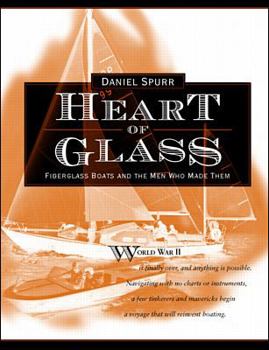Heart of Glass: Fiberglass Boats and the Men Who Built Them
Select Format
Select Condition 
Book Overview
Developed during World War Two, fibreglass transformed yachting, an exclusive pastime of the rich, into boating, a favoured leisure pursuit of America's growing middle class. This volume examines the... This description may be from another edition of this product.
Format:Hardcover
Language:English
ISBN:0071579834
ISBN13:9780071579834
Release Date:December 1999
Publisher:International Marine Publishing
Length:388 Pages
Weight:2.15 lbs.
Dimensions:1.1" x 7.7" x 9.6"
Customer Reviews
4 ratings
A Must have for boatnics
Published by Thriftbooks.com User , 15 years ago
Anyone who loves boats, especially sailboats, must have this book. Dan Spurr does a great job of outlining the history of fiberglass boats, and the entertaining stories of the people who made them. I keep my copy close at hand and refer to it often.
Interesting book marred by incorrect historical facts
Published by Thriftbooks.com User , 16 years ago
I was excited when I found a book devoted to the recent history of fiberglass boats. My enthusiasm was diminished by some of the incorrect historical information conveyed in the first hand accounts the author relies on. For example, on page 9 of the hard bound addition he quotes John Wills, "About 1942 . . . I was chief engineer and janitor for Western Plastics . . . That same year a small group from Cal Tech (headed by Dr. Wernher Von Braun, the rocketeer) called me to look at a jet assist take off device". In 1942 Dr. Wernher Von Braun was in Peenemuende Germany testing V-2 rockets for use against the Allied forces. He wasn't heading up any groups at "Cal Tech". Such an obvious mistake should have been caught by the author, or at least his publisher's proofreader and never have made it into the published edition.
Great for those who love taking "dock walks"
Published by Thriftbooks.com User , 19 years ago
What a super book! It has everything the average sailor could want to know about fiberglass. I have no idea how Bob Perry (one of the editorial reviewers) could read this in one evening. It's just packed with information about most of the American (and some international) sailboat builders, their boats, and in most cases their demise. A lot of "experts" at my marina proudly profess knowledge about the histories of the different boats but, after reading this book, I've discovered that many of their stories are not accurate. I you love sailboats and wonder who built them, where they were built, how they were built, and when; then you should get this book. You'll certainly have a better understanding of boat brochures touting the virtues of features like S-glass, Airex cores, and the Scrimp process. And your next marina dock walk to check out other boats will be so much more interesting.
A great read for anyone interested in business management
Published by Thriftbooks.com User , 22 years ago
This readable, well-researched, and often hilarious book will delight the dickens out of any boater, power or sail (great gift!!!). More broadly, anyone interested in business management -- what works, what doesn't work, and where technology fits in -- will find much to ponder in this book. Spurr chronicles the demise of dozens of failed boating companies; an all-too-frequent theme is the destruction that follows on a company's acquisition by a large corporation seeking to "diversify," which seems, inevitably, to result in bankruptcy. Of equal interest are the few stories of genuine and lasting success, typified by Catalina Yachts, founded by Frank Butler. Mr. Butler independently arrived at the conclusions reached, belatedly, by legions of high-priced consultants and business school professors: innovate to create new markets, build quality in, treat your employees as if they were part of your family, speak personally to customers, resist acquisition, and -- if possible -- remain privately held. There's also much to ponder for economists and business historians. Imagine what the automobile industry would be like if cars lasted for 50 years -- well within the lifespan of a properly maintained, well-built fiberglass yacht. Spurr remarks that the industry's greatest mistake, viewed cynically, was its failure to build obsolescence into its products. But another factor in the industry's overall decline is the recalcitrant character of fiberglass boat-building technology, which is notoriously resistant to assembly line methods; were you to visit the Beneteau, Catalina, or Hunter factories, you'd see labor-intensive, one-at-a-time boat building techniques that do not fundamentally differ from those of 50 years ago. Unable to lower production costs, companies have instead turned to volume as a way to force down supplier prices -- that's why you get three big, dominant manufacturers in this market -- but the result, overall, is that most new fiberglass yachts of reasonable length (30' and up) are too expensive for middle-class buyers. Fiberglass boats were invented by dreamers who wanted to bring boating to Everyman; Spurr suggests, soberingly, that the dream seems destined to die.




